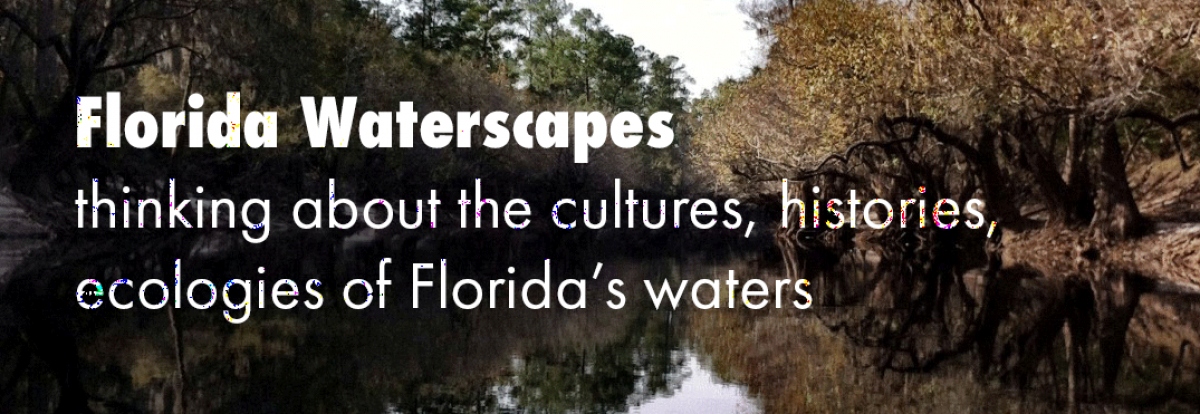
How was I supposed to focus on history with the deafening shrieks of children ringing in my ears? I had come to learn about the park’s history and perhaps even swim, but I quickly realized that every child from every camp from miles had also come to cool off in the spring. Oh well. I was preparing to teach a class on the culture, history, and ecology of Florida State Parks and was visiting the parks that exemplified kitschy pre-Disney Old Florida. With a water-skiing elephant and a sugar mill do-it-yourself pancake restaurant, DeLeon Springs made the cut. And despite my focus on tourist kitsch, I learned a great deal about the park’s rich history.
To escape the bedlam, I entered the one place guaranteed to be child-free: the park’s small museum. The room had posters, pictures, and artifacts that traced the area’s history, starting with the Mayaca people who inhabited the area for at least 6,000 years. Unfortunately, many burial mounds and artifacts were lost or destroyed when European settlers came to the region.

DeLeon Springs State Park sits between Deland and Astor, on the east side of the St. Johns River. Water coming from this second magnitude spring flows into Spring Garden Lake, then through Lake Woodruff and Lake Dexter en route to the St. Johns. Fish and game were plentiful for early Florida residents.
Easy access to the St. Johns River drew subsequent populations, starting with the Spanish in the 1500s. In the 1800s, settlers established Spring Garden Plantation to grow cotton and sugar cane. Florida’s history as a slave state is often over-looked, but slavery and plantations sadly thrived along the St. Johns River in the antebellum years.

In 1831-2, James John Audubon visited Spring Garden Plantation in search of the Common Gallinule. Unlike most visitors from the north, Audubon did not appreciate the scrub landscape that had enchanted William Bartram and Marjorie Kinnan Rawlings.
‘Here I am in Florida . . . which from my childhood I have consecrated in my imagination as the garden of the United States,’ Audubon wrote. But he found a place ‘where all that is not mud, mud, mud is sand, sand, sand, inhabited by alligators, snakes and scorpions.’

Spring Garden Plantation did not fare well in the mid-1800s. The Seminoles burnt it down during the Second Seminole War (1835-42), then Union troops burnt it again during the Civil War. Later the site was renamed DeLeon Springs, yet another Florida site claiming to be Ponce De Leon’s fountain of youth.


DeLeon Springs is the epitome of Old Florida tourism, and Queenie, the water skiing elephant, was DeLeon’s Springs crown jewel. In “The Waterskiing Elephants of DeLeon Springs“, Rick Kilby writes about Liz Dane who water-skiied with her pet elephant Queenie in 1958-9. In 2015, Liz Dane returned to DeLeon Springs to speak about Queenie and her experiences at the park.

Finally, enough history — it was time to get on the water. My paddling buddies and I see how far we could go on the spring run. Not far, as it turned out. The fin of my paddleboard caught in the mud on this shallow run. Even more ominous, dark clouds loomed over us. We raced back, not a moment too soon, and the skies broke. The silver lining: the typically long lines for the Old Spanish Sugar Mill Restaurant had disbursed. This restaurant is a tourist favorite for good reason. Each table has its own griddle, so guests make their own pancakes at the table.
We came for the kitsch and stayed for the history. Where ever I go in Florida, I am reminded of the deep and rich history of our rivers, springs, and parks. Deleon Springs State Park , though, has one of the most interesting blends of history, ecology, and recreation and is well worth a visit.




Visit the River of Dreams at the Matheson History Museum, 513 E University Avenue, Gainesville, FL 32601 Phone: (352) 378-2280
Hours: 11:00 a.m. – 4:00 p.m., Tuesday – Saturday
The Matheson will offer related programming from now through June, ranging from talks at the museum to paddling tours guided by Lars Anderson at Adventure Outpost. Visit the Matheson’s events page for details.
This exhibition emerged from the research of Dr. Whitney Sanford, Florence Turcotte, and students in the UF Religion Department, and was made possible by the generous support of Visit Gainesville; the State of Florida, Division of Cultural Affairs; and the Center for the Humanities and the Public Sphere at the University of Florida.
Thank you to our partners the Special & Area Studies Collections of the George A. Smathers Libraries at UF, UF Religion Department, and the UF Museum Studies Program, as well as the UF Florida Puerto Rico Digital Newspaper Project, the Laboratory of Southeastern Archeology, Department of Anthropology at UF and the National Park Service, Timucuan Ecological and Historic Preserve.
Curator: Briley Rasmussen
Associate Curators: Alexis Schuman and Lauren O’Neill
Guest curators: A. Whitney Sanford, Florence Turcotte
Assisted by: Peggy Macdonald, Sarah ‘Moxy’ Mocyzgemba, Amanda M. Nichols, Brian K. Szymborski
Exhibition Photographer: Anne Ledbetter
Mural Artists: Gillian Fazio and Laura North
Graphic Designer: Brianna Ostrowski

